

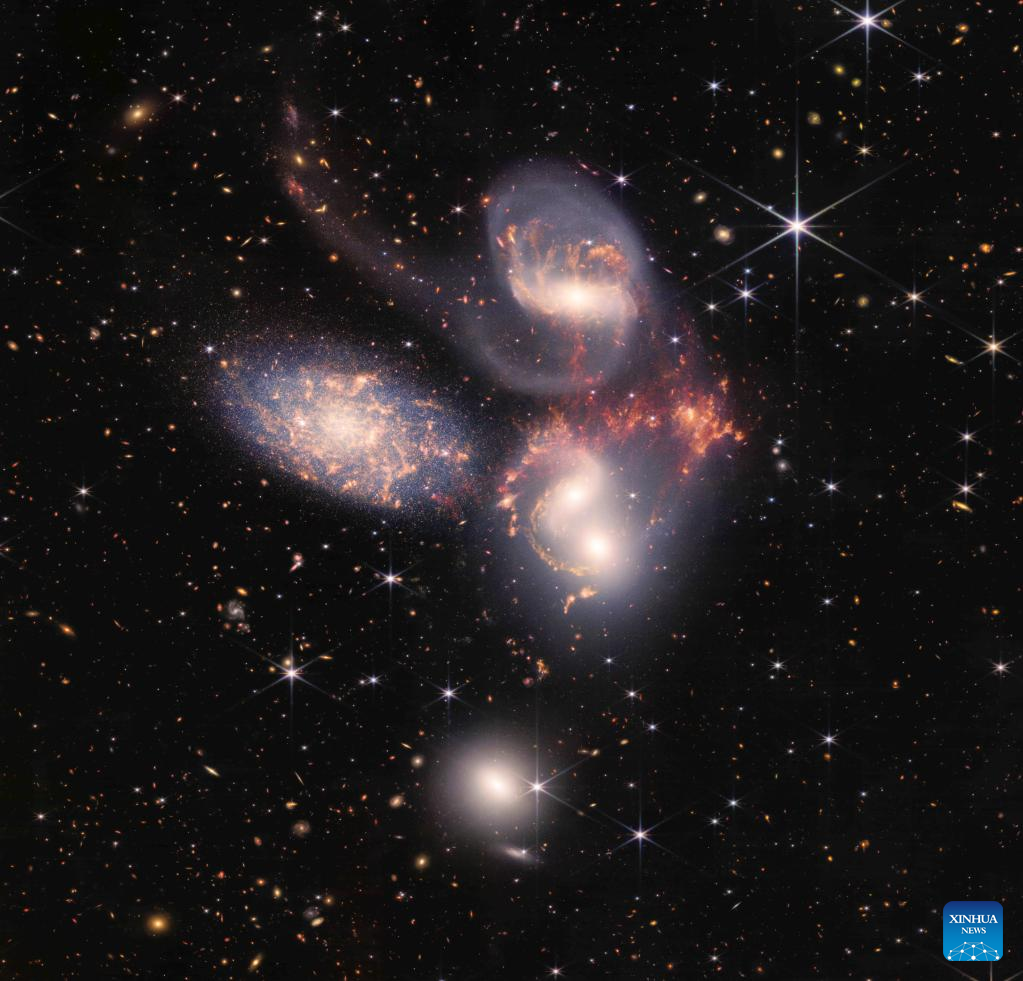
Image released by NASA on July 12, 2022 shows Stephan's Quintet, a group of five galaxies that appear close to each other in the sky: two in the middle, one toward the top, one to the upper left, and one toward the bottom. NASA released James Webb Space Telescope's first full-color images of the universe and their spectroscopic data on Tuesday, revealing the unprecedented and detailed views of the universe. (NASA, ESA, CSA, STScI/Handout via Xinhua)
LOS ANGELES, July 12 (Xinhua) -- NASA released James Webb Space Telescope's first full-color images of the universe and their spectroscopic data on Tuesday, revealing the unprecedented and detailed views of the universe.
Webb's first observations tell the story of the hidden universe through every phase of cosmic history - from neighboring exoplanets to the most distant observable galaxies in the early universe, said NASA.
"Today, we present humanity with a groundbreaking new view of the cosmos from the James Webb Space Telescope -- a view the world has never seen before," said NASA Administrator Bill Nelson.
The images released by NASA include detailed spectrum of an exoplanet atmosphere; Southern Ring Nebula, an expanding cloud of gas that surrounds a dying star which is approximately 2,000 light years away; Stephan's Quintet, a compact group of galaxies located in the constellation Pegasus; Carina Nebula, the earliest, rapid phases of star formation that were previously hidden.
On Monday, U.S. President Joe Biden unveiled another image produced by Webb, galaxy cluster SMACS 0723, which is filled with thousands of galaxies, including the faintest objects ever observed in the infrared.
"These images, including the deepest view of our universe that has ever been taken, show us how Webb will help to uncover the answers to questions we don't even yet know to ask; questions that will help us better understand our universe and humanity's place within it," Nelson said.
The release of Webb's first images and spectra kicks off the beginning of Webb's science operations, where astronomers around the world will have their chance to observe anything from objects within the solar system to the early universe using Webb's four instruments, according to NASA.
Webb was launched from the Guiana Space Center in Kourou, French Guiana, on Dec. 25, 2021, to probe structures and origins of the universe.
After completing a complex deployment sequence in space, Webb underwent months of commissioning where its mirrors were aligned, and its instruments were calibrated to its space environment and prepared for science.
Webb is NASA's largest and most powerful space science telescope ever constructed. With a 6.5-meter primary mirror, the large infrared telescope will study every phase of cosmic history, from within the solar system to the most distant observable galaxies in the early universe, according to NASA. ■
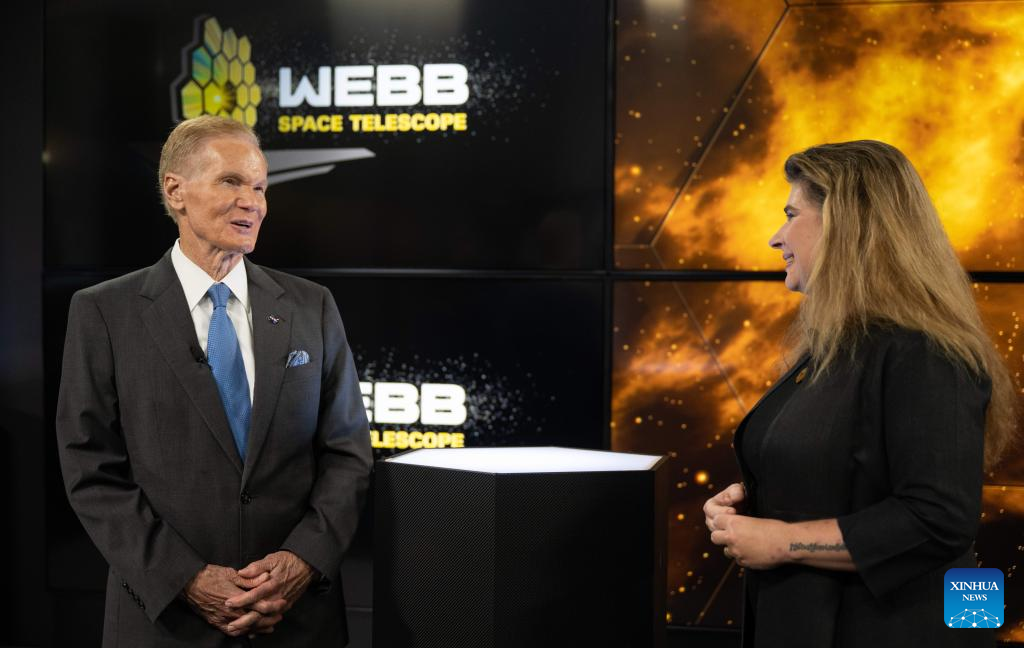
NASA Administrator Bill Nelson (L) speaks with Assistant Director of Science at NASA's Goddard Space Flight Center Michelle Thaller at NASA's Goddard Space Flight Center in Greenbelt, Maryland, the Untied States, on July 12, 2022. NASA released James Webb Space Telescope's first full-color images of the universe and their spectroscopic data on Tuesday, revealing the unprecedented and detailed views of the universe. (NASA/Bill Ingalls/Handout via Xinhua)

Image released by NASA on July 12, 2022 shows a side-by-side comparison of the Southern Ring Nebula in near-infrared light (L) and mid-infrared light (R) from NASA's James Webb Space Telescope. NASA released James Webb Space Telescope's first full-color images of the universe and their spectroscopic data on Tuesday, revealing the unprecedented and detailed views of the universe. (NASA, ESA, CSA, STScI/Handout via Xinhua)

The image captured by NASA's James Webb Space Telescope of the star-forming region called NGC 3324 in the Carina Nebula is seen on a screen at NASA's Goddard Space Flight Center in Greenbelt, Maryland, the Untied States, on July 12, 2022. NASA released James Webb Space Telescope's first full-color images of the universe and their spectroscopic data on Tuesday, revealing the unprecedented and detailed views of the universe. (NASA/Taylor Mickal/Handout via Xinhua)

Image released by NASA on July 12, 2022 shows Stephan's Quintet, a collection of five galaxies, as seen by MIRI from James Webb Space Telescope. NASA released James Webb Space Telescope's first full-color images of the universe and their spectroscopic data on Tuesday, revealing the unprecedented and detailed views of the universe. (NASA, ESA, CSA, STScI/Handout via Xinhua)
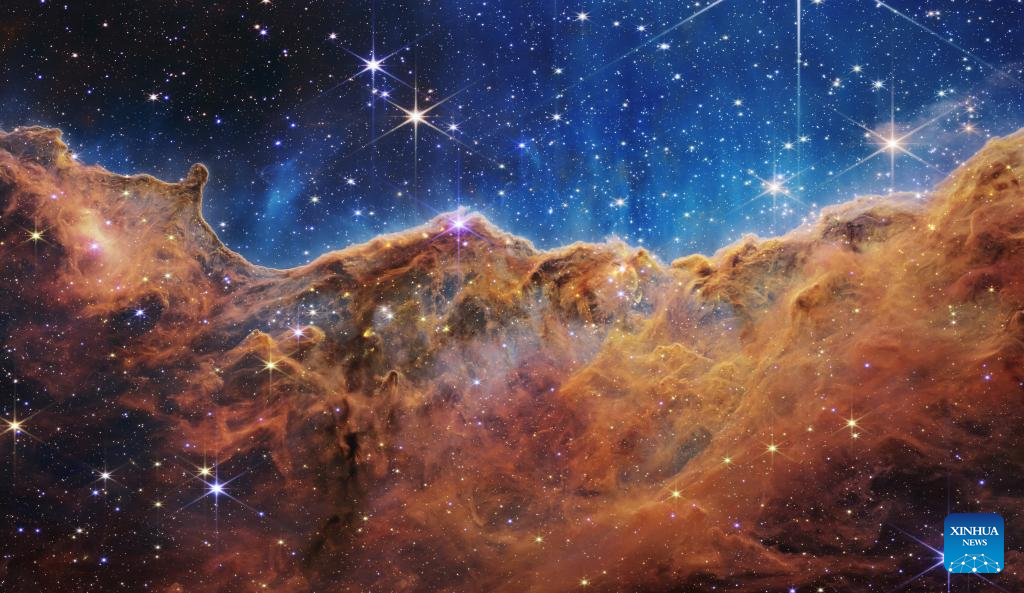
Image released by NASA on July 12, 2022 shows the edge of a nearby, young, star-forming region called NGC 3324 in the Carina Nebula. Captured in infrared light by NASA's James Webb Space Telescope, the image reveals for the first time previously invisible areas of star birth. NASA released James Webb Space Telescope's first full-color images of the universe and their spectroscopic data on Tuesday, revealing the unprecedented and detailed views of the universe. (NASA, ESA, CSA, STScI/Handout via Xinhua)
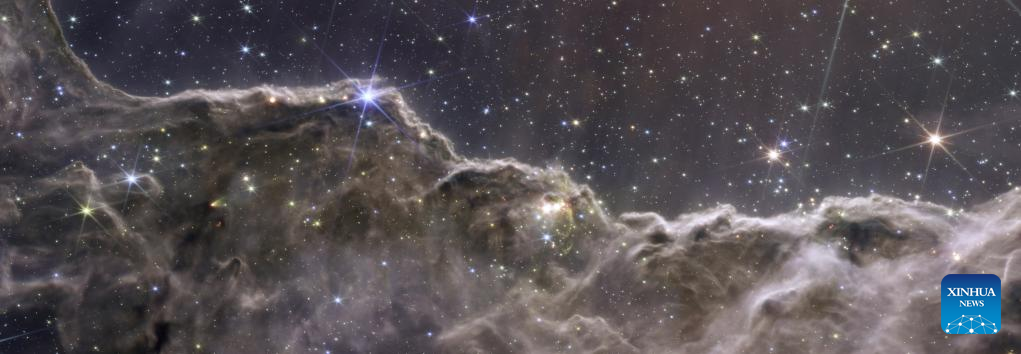
Image released by NASA on July 12, 2022 shows a composite image of the Cosmic Cliffs in the Carina Nebula, created with James Webb Space Telescope's NIRCam and MIRI. NASA released James Webb Space Telescope's first full-color images of the universe and their spectroscopic data on Tuesday, revealing the unprecedented and detailed views of the universe. (NASA, ESA, CSA, STScI/Handout via Xinhua)
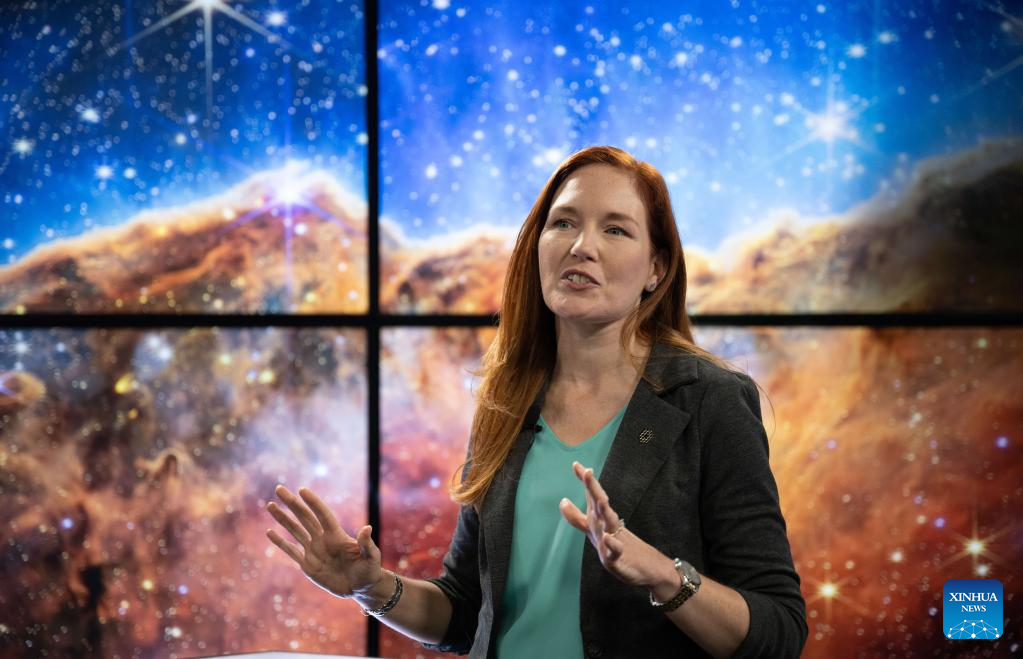
NASA James Webb Space Telescope Deputy Project Scientist for Communications Amber Straughn speaks about the infrared image of the star-forming region called NGC 3324 in the Carina Nebula as it is shown on a screen during a broadcast releasing the telescope's first full-color images at NASA's Goddard Space Flight Center in Greenbelt, Maryland, the Untied States, on July 12, 2022. NASA released James Webb Space Telescope's first full-color images of the universe and their spectroscopic data on Tuesday, revealing the unprecedented and detailed views of the universe. (NASA/Bill Ingalls/Handout via Xinhua)
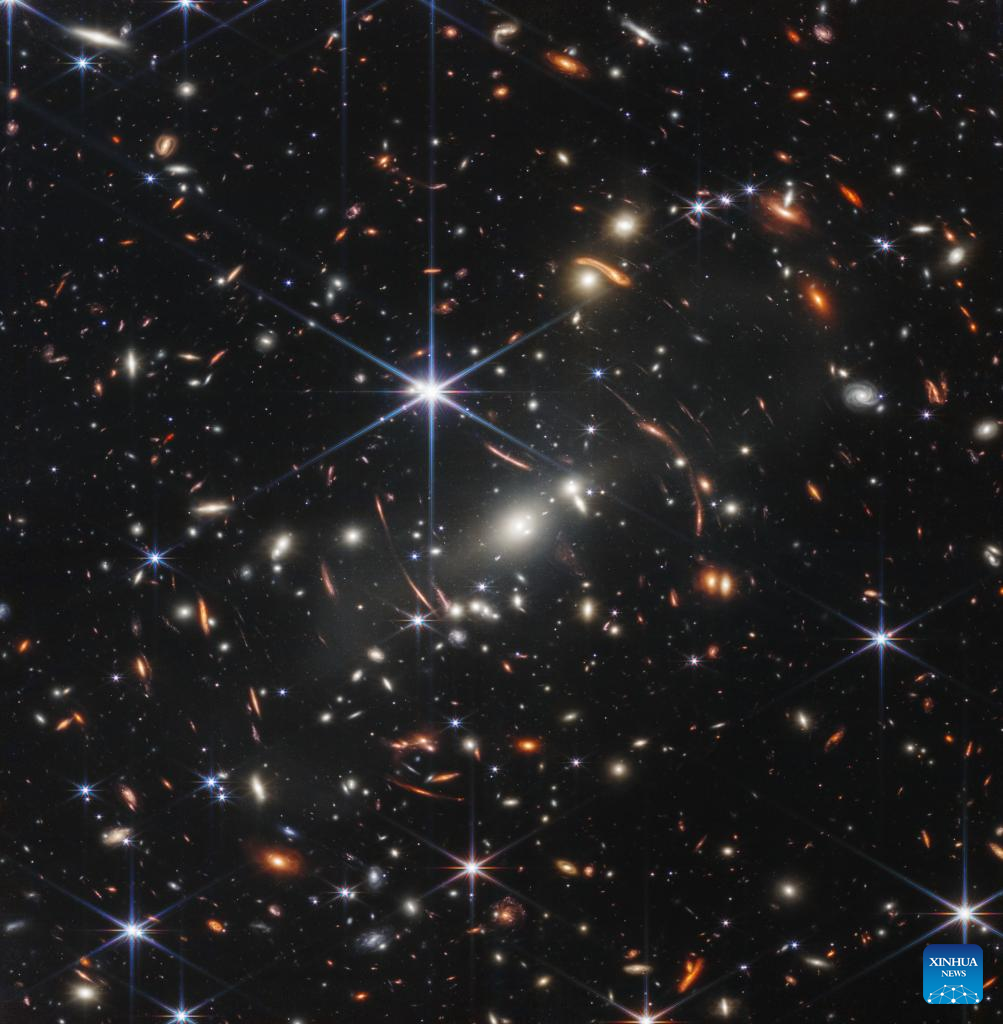
Image released by NASA on July 11, 2022 shows galaxy cluster SMACS 0723, captured by the James Webb Space Telescope.
U.S. President Joe Biden released one of the James Webb Space Telescope's first images in a preview event at the White House on Monday.
This first image from Webb is the deepest and sharpest infrared image of the distant universe to date, NASA said.
This image of galaxy cluster SMACS 0723 is filled with thousands of galaxies, including the faintest objects ever observed in the infrared, which have appeared in Webb's view for the first time, said NASA. (NASA/ESA/CSA/STScI/Handout via Xinhua)
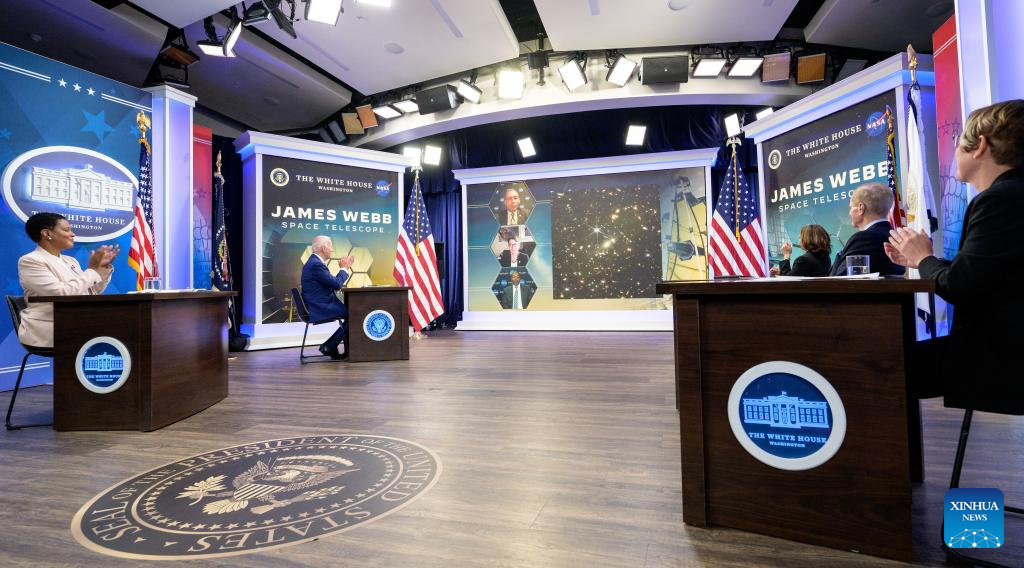
U.S. President Joe Biden (2nd L) attends a preview event to release one of the James Webb Space Telescope's first images at the White House in Washington, D.C., the United States, July 11, 2022.
U.S. President Joe Biden released one of the James Webb Space Telescope's first images in a preview event at the White House on Monday.
This first image from Webb is the deepest and sharpest infrared image of the distant universe to date, NASA said.
This image of galaxy cluster SMACS 0723 is filled with thousands of galaxies, including the faintest objects ever observed in the infrared, which have appeared in Webb's view for the first time, said NASA. (NASA/Bill Ingalls/Handout via Xinhua)
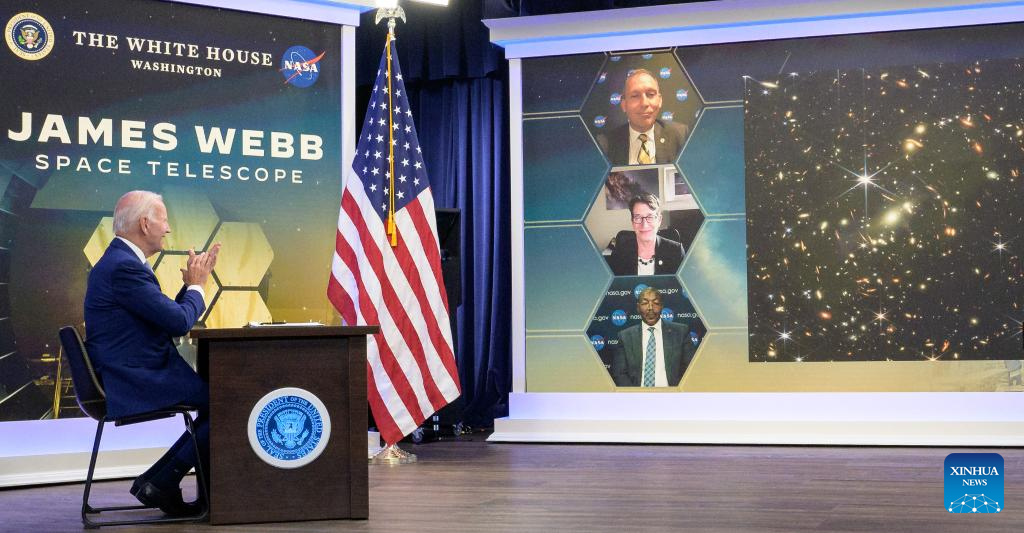
U.S. President Joe Biden attends a preview event to release one of the James Webb Space Telescope's first images at the White House in Washington, D.C., the United States, July 11, 2022.
U.S. President Joe Biden released one of the James Webb Space Telescope's first images in a preview event at the White House on Monday.
This first image from Webb is the deepest and sharpest infrared image of the distant universe to date, NASA said.
This image of galaxy cluster SMACS 0723 is filled with thousands of galaxies, including the faintest objects ever observed in the infrared, which have appeared in Webb's view for the first time, said NASA. (NASA/Bill Ingalls/Handout via Xinhua)
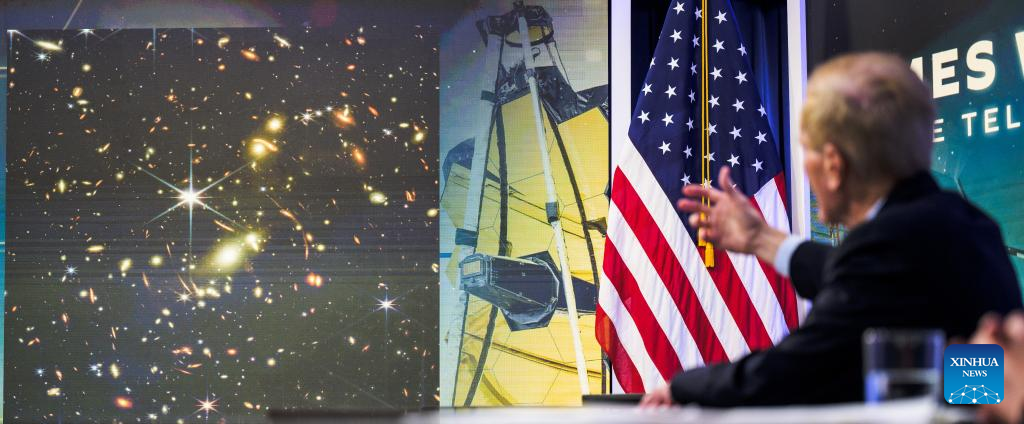
NASA Administrator Bill Nelson describes the first image from the James Webb Space Telescope at the White House in Washington, D.C., the United States, July 11, 2022.
U.S. President Joe Biden released one of the James Webb Space Telescope's first images in a preview event at the White House on Monday.
This first image from Webb is the deepest and sharpest infrared image of the distant universe to date, NASA said.
This image of galaxy cluster SMACS 0723 is filled with thousands of galaxies, including the faintest objects ever observed in the infrared, which have appeared in Webb's view for the first time, said NASA. (NASA/Bill Ingalls/Handout via Xinhua)
点击右上角![]() 微信好友
微信好友
 朋友圈
朋友圈

请使用浏览器分享功能进行分享
